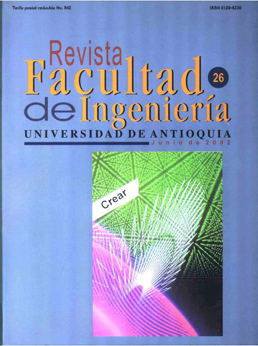Predicción de la calidad del lixiviado producido en rellenos sanitarios
DOI:
https://doi.org/10.17533/udea.redin.326358Palabras clave:
Relleno sanitario, lixiviado, lixímetros, residuos sólidos municipales, recirculación, biodegradable, modelo matemático.Resumen
Este artículo presenta un modelo matemático desarrollado con el propósito de predecir la concentración de los contaminantes presentes en el lixiviado producido por la biodegradación de los residuos sólidos dispuestos en un relleno sanitario. El modelo consiste en una ecuación cinética de primer orden, capaz de describir los procesos de degradación de la materia orgánica presente en los residuos sólidos. Este fue calibrado usando los resultados obtenidos a escala laboratorio mediante la utilización de seis lixímetros operados bajo diferentes condiciones. El modelo predijo la concentración de los contaminantes en el lixiviado con una exactitud del 94%.Descargas
Citas
Ravch, A., and Avnimelech, Y. (1979). "Leachate of pollutans from sanitary landfill models". En: J. Water Pollution Control Fed. 51(11). pp. 2.705-2.716.
Wing, R. J. ( 1979). "Boone country field site interim report". Rep. Nro. EPA 600/2-79-058. U.S.
Reitzel, S., Farquhar, G., et al. ( 1992). "Temporal characterization of municipal solid waste leachate". Can. J Civ. Engerg. Ottawa, (8). pp. 756-767.
Straub, W. A., and Lynch, D. R. ( 1982a). "Models of landfill leaching: Moisture flow and inorganic strength". J Engrg. Div., ASCE. 108(2). pp. 231-250. DOI: https://doi.org/10.1061/JEEGAV.0001276
Monod, J. (1949). "The growth of bacterial cultures". Ann. Rev. Microbiol., 3, 371-385. DOI: https://doi.org/10.1146/annurev.mi.03.100149.002103
Straub, W. A., and Lynch, D. R. ( 1982b ). "Models of landfill leaching: Organic strength". J. Engrg. Div. ASCE, l08(2). pp. 251-268. DOI: https://doi.org/10.1061/JEEGAV.0001277
Korfiatis, G. and Demetracopoulos, A. (1984) "Moisture transport in a solid waste column". J Envir. Engrg. ASCE, 110(4). pp. 780-796. DOI: https://doi.org/10.1061/(ASCE)0733-9372(1984)110:4(780)
Demetracopoulus, a. c., Sehayek, L., et al. (1986). Modeling leachate production from municipal landfills" J. Envir. Engrg. ASCE, 112(5). pp. 849-866. DOI: https://doi.org/10.1061/(ASCE)0733-9372(1986)112:5(849)
Colin, F. (1990) "Estude de la modelisation desfonctions assurees par une descharge (Study of the modelizartion of processes occurring in a landfill)". lnstitut de rechearches hydrologiques. Nancy, France.
Gonullo, M. T. ( 1994). "Analytical modeling of organic contaminants in leachate". Waste Mgmt. And Res., 12 (4). pp. 141-150. DOI: https://doi.org/10.1006/wmre.1994.1004
Wing, R. J. (1979). "Boone County field site interim report". Rep No. EPA 600/2-79-058, U.S. EPA.
Ehrig, H. J. (1988). "Water and Element Balances of Landfills". Earth Sciences. The Landfill. New York. P. Baccini Ed. pp. 83-115. DOI: https://doi.org/10.1007/BFb0011259
Pohland, F, G. (1980). "Leachate recycle as landfill management option". J. Envir. Engrg. Div. ASCE, l06 (6). pp. 1.057-1.069. DOI: https://doi.org/10.1061/JEEGAV.0001108
Tittlebaum, M. E. (1982). "Organic carbón conten stabilization thougth landfill leachate recirculation". J Water pollution Control Fed. 54 (5). pp. 428-433.
Descargas
Publicado
Cómo citar
Número
Sección
Licencia
Los artículos disponibles en la Revista Facultad de Ingeniería, Universidad de Antioquia están bajo la licencia Creative Commons Attribution BY-NC-SA 4.0.
Eres libre de:
Compartir — copiar y redistribuir el material en cualquier medio o formato
Adaptar : remezclar, transformar y construir sobre el material.
Bajo los siguientes términos:
Reconocimiento : debe otorgar el crédito correspondiente , proporcionar un enlace a la licencia e indicar si se realizaron cambios . Puede hacerlo de cualquier manera razonable, pero no de ninguna manera que sugiera que el licenciante lo respalda a usted o su uso.
No comercial : no puede utilizar el material con fines comerciales .
Compartir igual : si remezcla, transforma o construye a partir del material, debe distribuir sus contribuciones bajo la misma licencia que el original.
El material publicado por la revista puede ser distribuido, copiado y exhibido por terceros si se dan los respectivos créditos a la revista, sin ningún costo. No se puede obtener ningún beneficio comercial y las obras derivadas tienen que estar bajo los mismos términos de licencia que el trabajo original.










 Twitter
Twitter